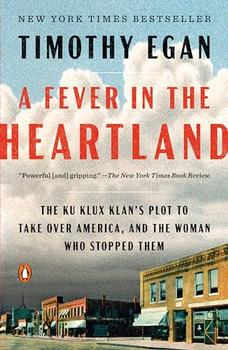Summary | Excerpt | Reviews | Beyond the Book | Readalikes | Genres & Themes | Author Bio
The Ku Klux Klan's Plot to Take Over America, and the Woman Who Stopped Them
by Timothy Egan

Critics' Opinion:
Readers' Opinion:
First Published:
Apr 2023, 432 pages
Paperback:
Jun 4, 2024, 448 pages
 Book Reviewed by:
Book Reviewed by:
Valerie Morales
Buy This Book
1.
Birth and Death of the Klan
1866–1872
When white-sheeted nightriders first appeared in the dark Southern night, many people thought they were ghosts. That was the idea: the souls of those who'd died for a republic of slaveholders had returned from their graves. They were out for vengeance, and they were invisible. They burned houses and churches, stole crops and food, dragged men from their farms and whipped them until they fell, ripped teachers from schoolhouses and branded their foreheads, raped women in front of their children, and shot their husbands at point-blank range. During rampages, they often displayed skeletal hands from beneath their robes, rattled chains, or removed fake heads—all to further the scare of a spectral and invincible force. In daylight, they vanished. The morning after a raid, a victim might come across the man who had torched his barn, the clerk at the mercantile store, and know nothing of his role in the nocturnal horror. But they were not ghosts. The hooded horsemen were part of the unmoored mass of defeated Confederate soldiers, more than half a million men who'd surrendered on the condition that they not "take up arms against the United States." Though conquered, they were free to return home, free to farm and bank and own property, eventually free to vote and hold office. For the most part, traitors were not tried.
In early 1866, six of those rebel veterans met in Pulaski, in Middle Tennessee a few miles north of the Alabama border, to form a secret club. The market town of 2,000 people was named for a Catholic immigrant from Poland who'd fought for the Americans against the British. Before the Civil War, almost half the county was enslaved. Now they walked the streets—freedmen and freedwomen. They attended schools, held worship services, and made plans to vote. President Lincoln had established a Freedmen's Bureau to help people who'd been held in bondage become people with tools to make a living on their own. His generals had offered reparations—forty acres and a mule, carved out of land seized from more than 70,000 slaveholders. But his successor, Andrew Johnson, had overturned the order just a few months after Lincoln was assassinated. The task of peace, as Walt Whitman had prophesied, would be more difficult than the war itself.
Two of the young men gathered in Pulaski had been Confederate officers. Two were lawyers. One was a newspaper editor. One was a cotton broker. They were adrift, bored, and bitter, chafing at new life in the South after four million enslaved people had been freed, and would soon make up 36 percent of the citizen population. The Greek word kuklos, representing a circle, was offered as a name. Klan was an alliterative pairing of the first word, and an echo of the clans to which the Old World ancestors of these Scots-Irish Protestants had belonged. A costume came together: a conical top to make the wearer look much taller, a white mask with cutouts for eyes, a long robe with symbols stitched to it. Silly rituals and silly titles were invented. When the first public parade was held in Pulaski, the original six had expanded to seventy-five masked men marching in the street. The local paper printed a story a week about this mysterious new club. What was the purpose? Brotherhood. Mystery. And power. "The first meeting was purely social," wrote James R. Crowe, one of the original half-dozen. "We would frequently meet after the day's business was over in some room or office. We would have music and songs."
His framing of the founding was a not-so-sly bit of myth-crafting. Before long, the music and song had become arson and whipping. In early 1867, a Tennessee paper reported the rise of "some general and unrefined dread among Negroes of a secret order that has recently made its appearance." And that secret order had spread beyond Pulaski. At a regional convention in Nashville, a prominent Tennessean, Nathan Bedford Forrest, declared himself the first Grand Wizard. As a Confederate general, Forrest was notorious for the Fort Pillow Massacre, the execution of about 150 Black Union soldiers who had thrown down their arms and surrendered. On his orders, they were bayoneted, clubbed to death, and "shot down like dogs," one Confederate soldier wrote. Pardoned by Johnson of the war crime, Forrest had trouble making a living in an economy no longer built on human property. Beady-eyed and bewhiskered, he loathed the idea of the Black race standing on equal terms with whites. "The Negroes were holding night meetings, were going about, were being very insolent," Forrest explained in a congressional hearing. "Ladies were ravished by some of these Negroes."
Excerpted from A Fever in the Heartland by Timothy Egan. Copyright © 2023 by Timothy Egan. All rights reserved. No part of this excerpt may be reproduced or reprinted without permission in writing from the publisher.





The Funeral Cryer by Wenyan Lu
Debut novelist Wenyan Lu brings us this witty yet profound story about one woman's midlife reawakening in contemporary rural China.
Your guide toexceptional books
BookBrowse seeks out and recommends the best in contemporary fiction and nonfiction—books that not only engage and entertain but also deepen our understanding of ourselves and the world around us.